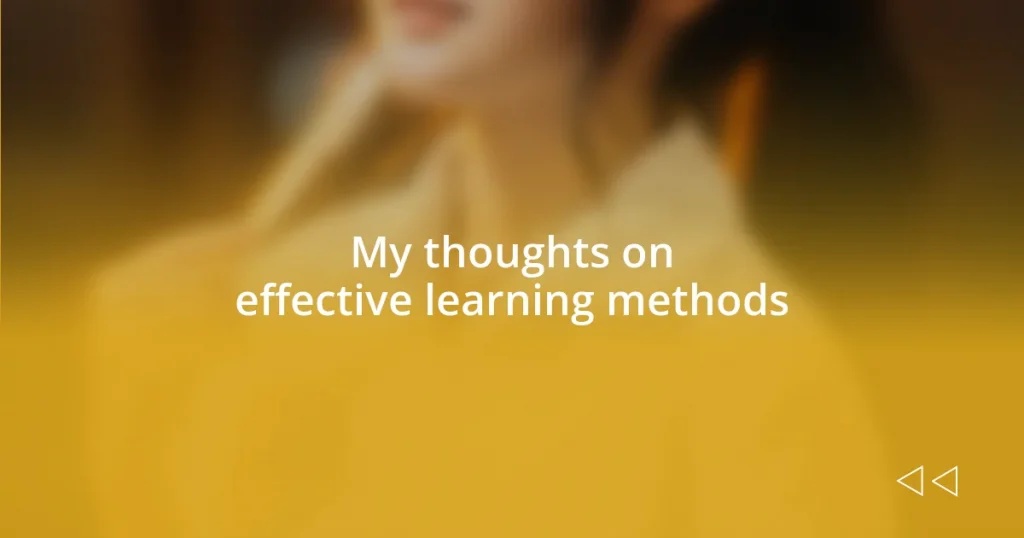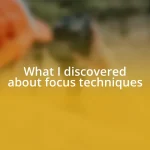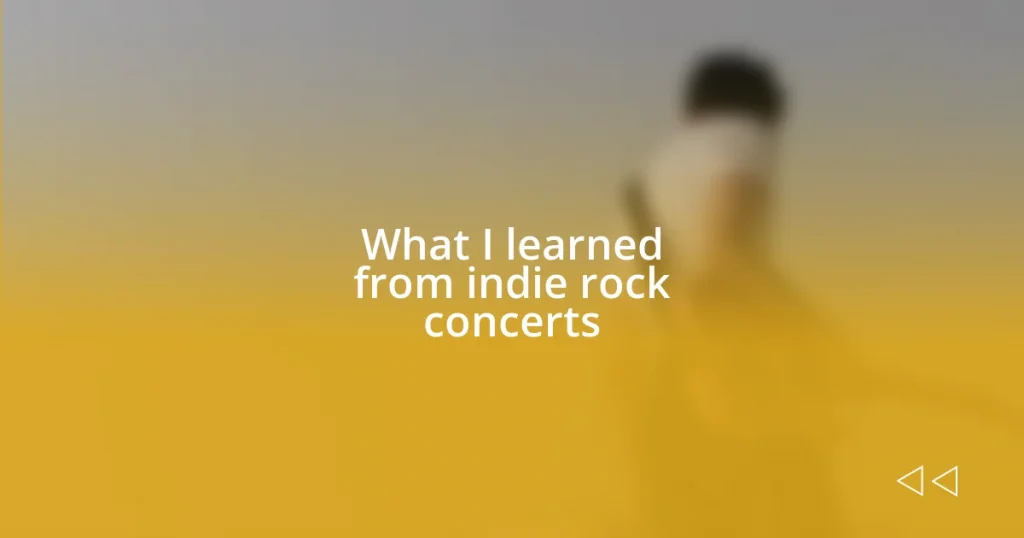Key takeaways:
- Active engagement through group discussions, questioning, and hands-on experiences significantly enhances understanding and retention of information.
- Setting clear, personalized goals provides direction and motivation, transforming overwhelming tasks into manageable milestones.
- Utilizing multimodal learning—incorporating various sensory methods—deepens comprehension and retention, making the learning process dynamic and enjoyable.
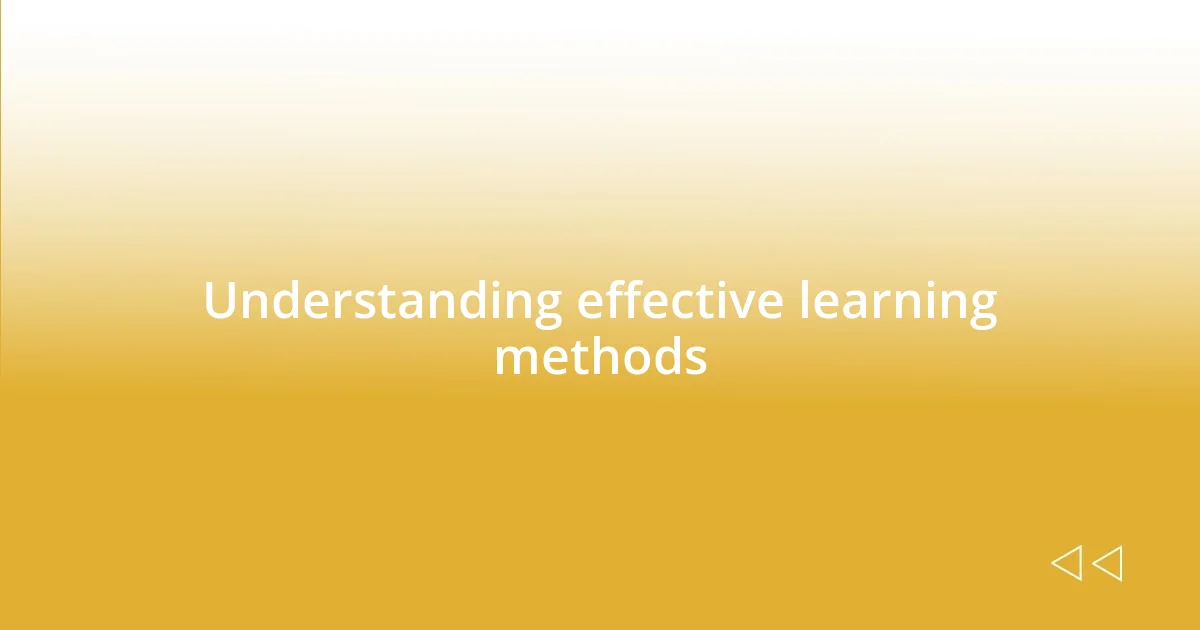
Understanding effective learning methods
Effective learning methods are often rooted in understanding how we, as individuals, retain and process information. Think about a time when you struggled to grasp a complex concept. I remember sitting in a math class, feeling lost while everyone else seemed to get it. It was only when I engaged with the material through practice problems and group discussions that things started to click. Reflecting on that experience, I realized that active participation often deepens understanding better than passive listening.
One important aspect of effective learning is personalization. Have you ever noticed how a particular technique resonates with you while another leaves you baffled? For me, using visual aids like diagrams and mind maps helped transform obscure ideas into clearer images. They not only made studying more enjoyable but also enhanced my ability to recall information during exams. This personalization in learning methods highlights the importance of identifying which strategies work best for each of us.
In addition, integrating different styles of learning also proves beneficial. I often find that switching between auditory, visual, and kinesthetic methods keeps things fresh and engaging. For instance, when studying a new language, listening to music or podcasts in that language adds a fun twist while reinforcing vocabulary. It’s moments like these that show me just how versatile and dynamic the learning process can be, encouraging exploration and discovery along the way.
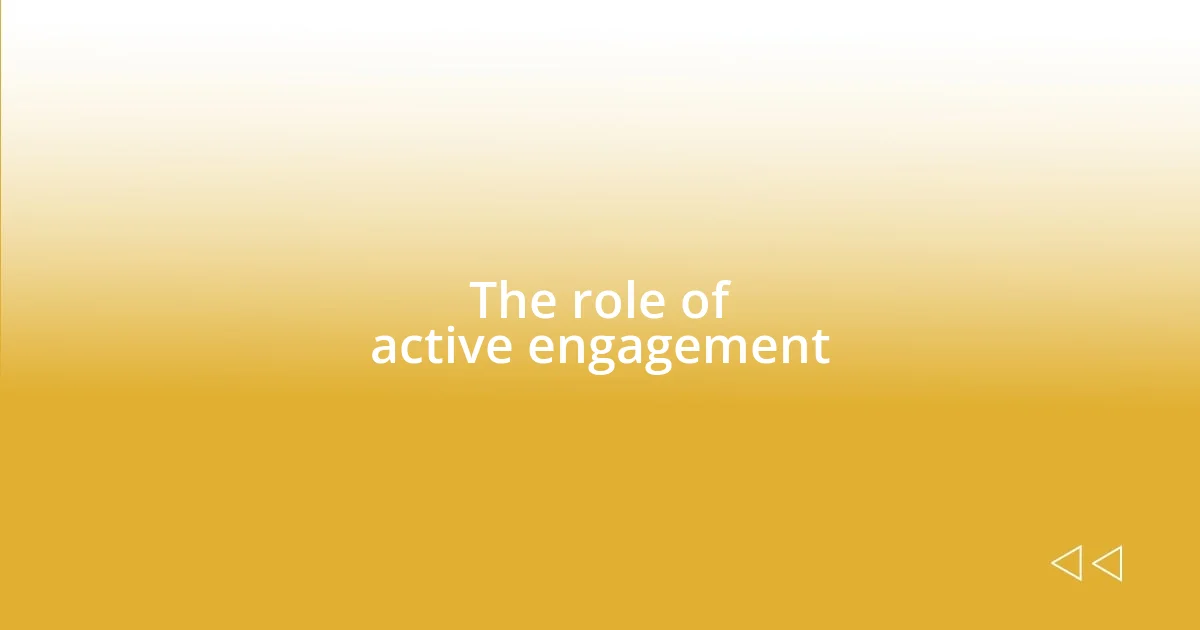
The role of active engagement
Engaging with the material is crucial for effective learning. I remember a particular group project in college where we had to research a topic and present our findings. Rather than just dividing up the work and compiling everyone’s contributions, we decided to work together in brainstorming sessions. I felt a noticeable shift in my understanding; discussing our ideas made the subject matter come alive. Active engagement like this fosters a deeper connection and promotes better retention of information.
Moreover, I’ve found that asking questions is an excellent way to stay engaged. In my experience, whenever I encountered a challenging topic, raising questions often opened the door to discussions that clarified confusion. For instance, during a lecture on psychological theories, I began to query the application of certain concepts. This not only enriched my learning but also encouraged my peers to dive deeper with me. It’s this kind of interaction that ignites curiosity and solidifies comprehension.
Lastly, incorporating hands-on experiences can amplify learning. One of my fondest memories is when I participated in a community service project related to environmental science. The practical application of classroom theories in a real-world setting was transformational. I discovered that feeling connected to the material—seeing its effects—grounded my understanding in ways lectures couldn’t. Active engagement through real-life experiences makes learning not just theoretical, but tangible, which is immensely rewarding.
| Active Engagement Method | Impact on Learning |
|---|---|
| Group Discussions | Enhances understanding and promotes retention |
| Questioning | Stimulates curiosity and deepens comprehension |
| Hands-On Experiences | Transforms theory into tangible knowledge |
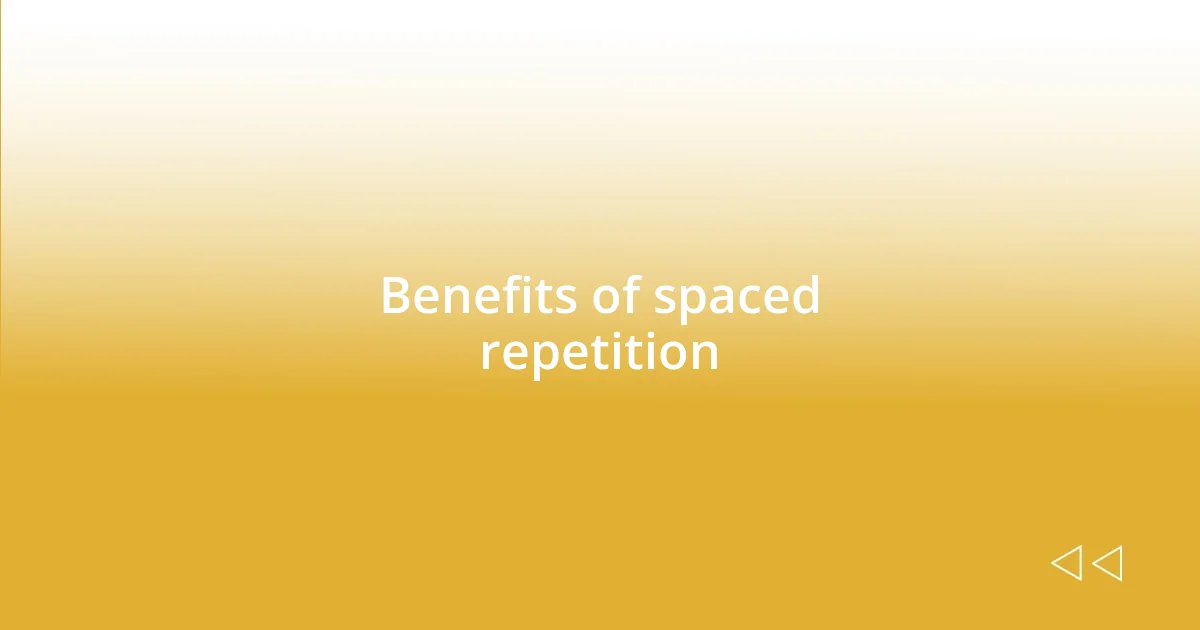
Benefits of spaced repetition
Spaced repetition has been a game changer in my own study strategies. I recall stumbling through my first attempts at learning a new language; the vocabulary felt overwhelming at first. However, by incorporating spaced repetition into my routine, the words started to stick. It felt like putting pieces of a puzzle together. Each time I revisited that vocabulary after increasing intervals, I found it not only easier to remember but also to use in conversation. This cyclical pattern of review helps reinforce material right at the moment when I’m most likely to forget it, transforming memory from a struggle into a process that felt almost natural.
The benefits of spaced repetition extend beyond simple memorization. I have observed that it cultivates a sense of mastery and confidence. When I use this method, I gradually notice a shift in how I approach learning; rather than cramming before an exam, I feel equipped and prepared. Here are some key advantages I’ve experienced:
- Long-Term Retention: It boosts my ability to recall facts long after I initially learned them.
- Efficiency: I can cover large amounts of material more effectively by focusing on what I’ve yet to master.
- Decreased Anxiety: Reassured by my ongoing reviews, I feel less overwhelmed during exams and presentations.
This approach has not only made learning feel more manageable but also more rewarding as I see my progress unfold over time.
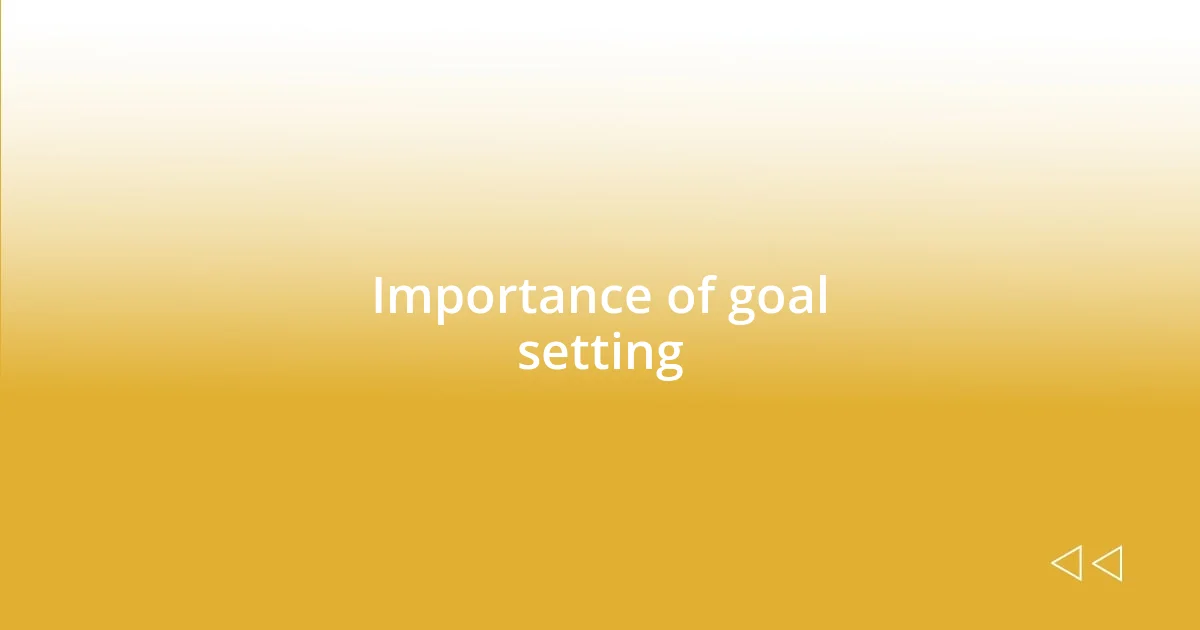
Importance of goal setting
Setting goals has a profound impact on my learning journey. I remember when I first decided to tackle a challenging subject—I set a specific target to finish a certain textbook chapter each week. This simple act of outlining my objectives transformed what could have been an overwhelming task into manageable milestones. Isn’t it amazing how turning vague ambitions into clear, defined goals can create a sense of purpose?
When I reflect on my academic experiences, I realize how goal setting led me to long-term success. For instance, I once aimed to master a difficult statistical software program within two months. By breaking that down into weekly targets, I not only learned the software but also gained confidence. The sense of achievement I felt after each completed goal was like fuel for my motivation. How can we underestimate the power of small victories in shaping our overall progress?
Moreover, goals act as a compass, guiding my study habits and daily priorities. I vividly remember a period when I juggled multiple responsibilities. Setting clear priorities helped me focus on what genuinely mattered. It’s like having a roadmap—when distractions arise, I can effortlessly redirect my attention. Have you ever experienced that rush of clarity when you know exactly what you need to focus on? That feeling is invaluable in a world full of noise.
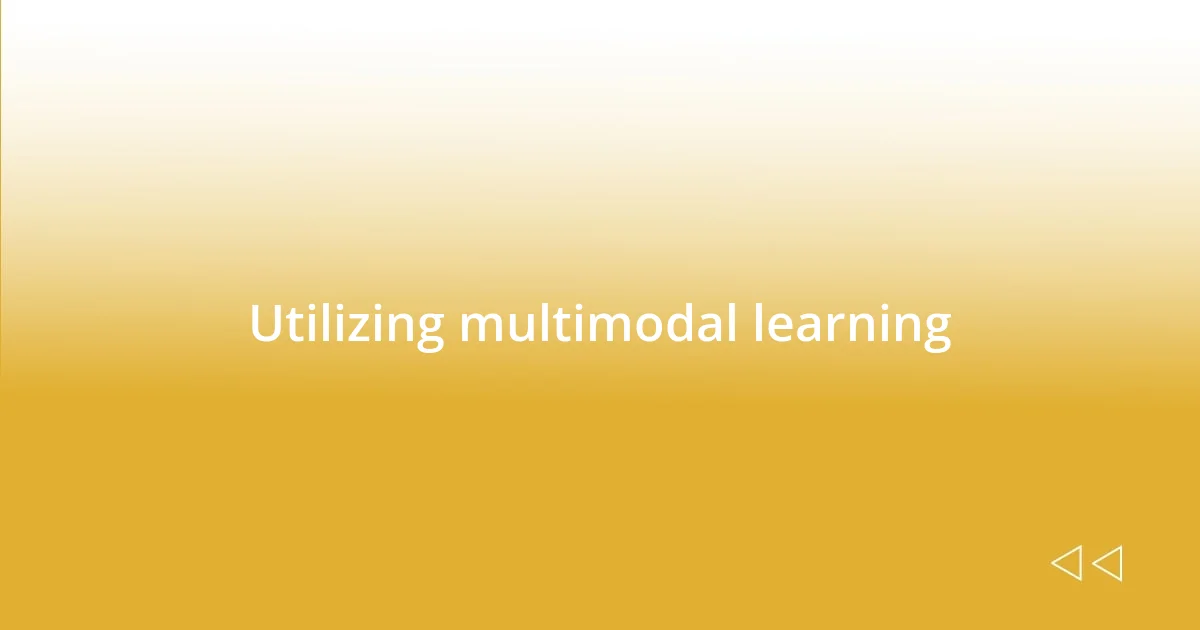
Utilizing multimodal learning
I’ve come to appreciate the magic of multimodal learning as it truly enhances the way I absorb information. I remember a time when I was preparing for an important presentation; instead of simply reading through my notes, I used videos, infographics, and even podcasts on the topic. This variety invigorated the learning process and made the content stick. Have you ever noticed how different formats can spark your curiosity in unexpected ways? That’s the beauty of engaging multiple senses.
Through my experience, I’ve found that stimulating different modalities—visual, auditory, and kinesthetic—helps to create a richer learning environment. For instance, when I was mastering a particular coding language, watching tutorials while simultaneously coding along made the concepts much clearer. It was like having the best of both worlds. I can’t help but wonder: how often do we limit our learning by sticking to just one method? By embracing multimodal strategies, we can expand our understanding and find new connections between ideas.
Incorporating various learning styles also helps me retain information longer, especially when I relate the content to my own experiences. I recall vividly when I learned about ecosystems; using diagrams to visualize food chains and then explaining it to a friend brought the information to life. This active involvement not only reinforced my understanding but also made it more enjoyable. Isn’t it amazing how integrating different methods can transform what feels like a chore into something dynamic and fun?
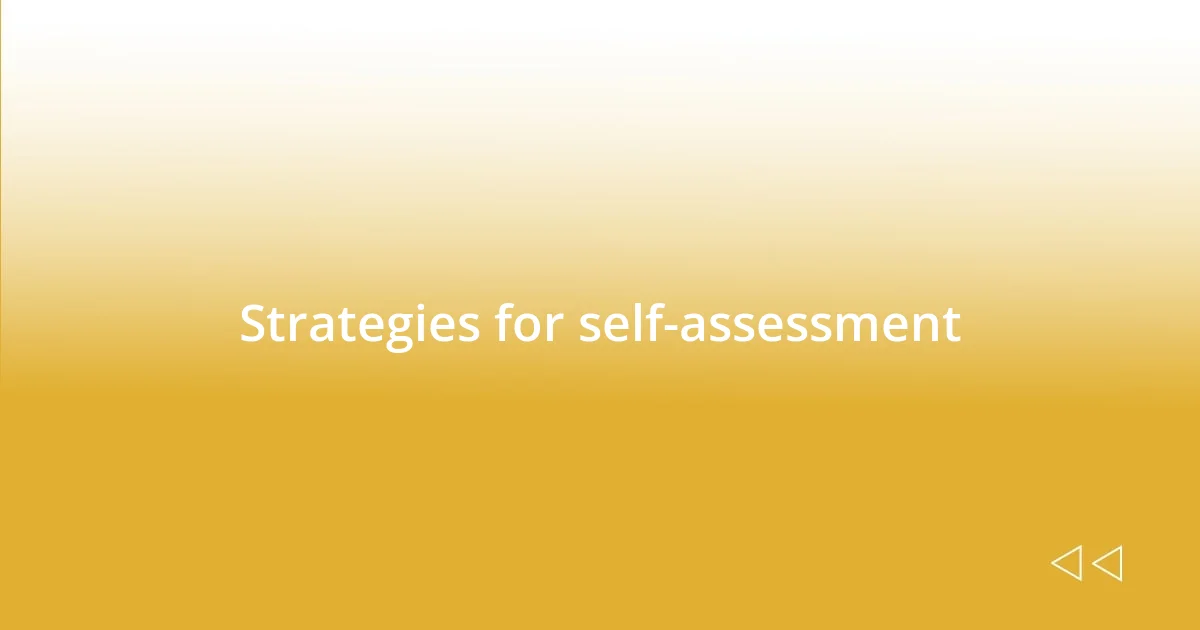
Strategies for self-assessment
One effective strategy for self-assessment that I’ve embraced is keeping a learning journal. I started this practice during my final year of college when I often felt overwhelmed. Not only did writing down my thoughts after each study session help me identify areas where I struggled, but it also allowed me to celebrate my small victories. Have you ever felt that rush when you realize you understand a concept that previously baffled you? Capturing those moments has been incredibly rewarding.
Another approach I find useful is creating self-quizzes based on my study material. I remember preparing for exams by drafting questions that challenged my understanding. This method not only accentuated my weak spots but also gave me the confidence boost I needed, as answering them correctly felt like a victory. Isn’t it interesting how testing ourselves can sometimes reveal just how much we know, while also highlighting areas for improvement?
Lastly, peer feedback has been a game-changer in my self-assessment journey. I began inviting a study partner to discuss assignments, which drastically improved my perspective. Their insights often pointed out aspects I hadn’t considered, fostering a deeper understanding of the material. Have you ever had a moment where a friend’s perspective changed your entire outlook on a topic? Those conversations can be enlightening and pave the way for more profound self-reflection.
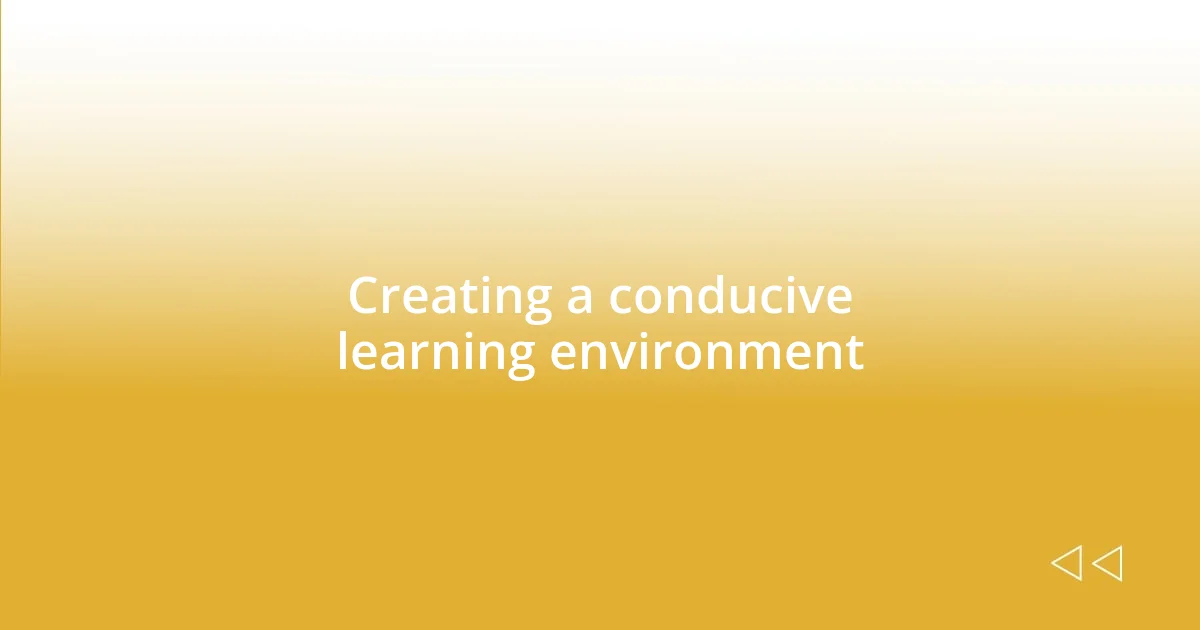
Creating a conducive learning environment
Creating a conducive learning environment hinges on comfort and organization. I vividly recall a time when I decided to rearrange my study space. I cleared away clutter, added some soft lighting, and even played gentle background music. Being in that serene setting made a world of difference; I felt my focus sharpen and my creativity flow. Have you ever noticed how a simple change in your environment can influence your mindset?
Another essential aspect is minimizing distractions. During a particularly intense study week, I realized that my phone was a constant source of interruption. I took a leap and installed a focus app that blocked notifications for a set period. It was transformative! Suddenly, I was completely immersed in my work. Have you ever tried putting your phone away for a while? It’s amazing how quickly you can get lost in your studies when you eliminate interruptions.
Incorporating personal elements into the study space can also enhance the learning atmosphere. I’ve found that surrounding myself with inspiring quotes or images related to my goals uplifts my spirit. There’s something about seeing reminders of why I’m learning that keeps me motivated. Do you have anything in your space that inspires you? Having those personal touches can turn an ordinary workspace into a sanctuary for growth and discovery.










